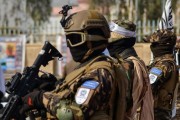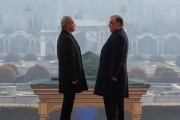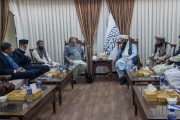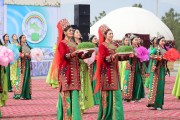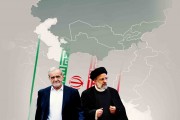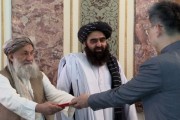Publish Date
Tuesday 12 September 2023 - 11:44
recommended
1
GCC-Central Asia developing relations: Opportunities and challenges
The strategic policy of the Central Asian countries is now affected by the developments in Afghanistan, and especially the Ukraine crisis. The escalation of conflict between Russia and the West, and the Taliban coming to power in Afghanistan, have forced many major players to pay more attention to Central Asia. Therefore, the popularity of the meetings in the form of 5+1 which is Central Asia plus the U.S / China / Japan / India, as well as Central Asia plus the European Union, and Central Asia plus the Gulf Cooperation Council (GCC) states indicate the competition of influential powers in the region to increase their influence in Central Asia.
IESS interview with “Andrei Grozin”; head of the Department of Central Asia and Kazakhstan at the Institute of CIS Countries
The U.S withdrawal from Afghanistan and the Taliban’s regaining power in Afghanistan on the one hand, and Russia's involvement in the Ukraine war on the other hand, has led to the formation of a power vacuum in Central Asia. This vacuum has aroused the interest of other powers to this region, and intensified the current geopolitical competition between the West and the East in the region. Given this geopolitical and geo-economic challenges, it seems that the Gulf Cooperation Council (GCC) and the Central Asia countries are seeking to create new areas of cooperation, in order to reduce the regional effects of the great powers’ competition in the Middle East and Central Asia.
Recently, the first meeting of heads of states of the GCC and Central Asia was held in Jeddah. In order to examine the potential impact of this summit on the cooperation between Central Asia and the Arab world, and the prospect of this developing cooperation for the region, the Institute for East Strategic Studies (IESS) had an exclusive interview with “Andrei Grozin”; head of the Department of Central Asia and Kazakhstan at the Institute of CIS Countries and senior researcher at the Institute of Oriental Studies of the Russian Academy of Sciences. The interview is as follows:
IESS: One of the concrete trends in the foreign policy of Arab countries has been to strengthen a kind of Look East policy. Is strengthening the interactions of these countries with Central Asia also evaluated in this framework? Or may it have other motives?
Grozin: It is a fact that the Central Asian states’ interest in the Arab world is increasing, and the prospect for this cooperation also seem very broad. There are several reasons for the attention of the Persian Gulf countries to the Central Asian region. First, in recent years, the geopolitical situation has generally changed both globally and in the Central Asia. Until recently, this region was considered under the dominant influence of Russia and China. However, today Moscow has focused all its resources and attention on confronting the West, which has led to the creation of a geopolitical vacuum in Central Asia.
On the other hand, the expectation of the Central Asian states to attract the Arab states’ investments has not been met. Projects related to the new transit routes that connect Central Asia with other regions are also constantly underfunded. Connecting Central Asia to Gulf countries requires crossing the territory of third countries such as Iran, Afghanistan or Pakistan, but this process is not easy due to the lack of investment and the unstable situation in Afghanistan. I should remind you that Tashkent has been trying to build a railway route to the Indian Ocean through Afghanistan and Pakistan for years. Therefore, at the recent GCC-Central Asia Summit, Shaukat Mirzayev asked the Arab countries to actively participate in the construction of the Trans-Afghan railway, which connects Pakistan and India to Central Asia in the shortest route. But this route also has to pass through unstable Afghanistan, so it is not believed that the Persian Gulf states are willing to invest in this project. Therefore, I am skeptical about the joint statement of cooperation between these regions, as well as in general about the statements that are made about grand plans.
In terms of trade, the value of exchange between the GCC and Central Asia countries amounted to $3.1 billion in 2021, about 0.27% of the total value of the GCC merchandise trade. The value of GCC exports to Central Asia amounted to $2.06 billion in 2021, while imports amounted to $1.04 billion. The main goods imported from Central Asia were copper, gold and other precious metals, and iron and steel.
Experience has shown that Arab businessmen prefer to invest in countries that have a good investment environment, while according to international rankings, Central Asian countries are still lagging behind most other regions in terms of foreign investment attractiveness. However, Arab countries have a Look East policy, and also intend to expand their economic and commercial relations as well as their access to the mineral resources of the Central Asian republics.
IESS: The geopolitics of Central Asia in the new period, affected by the developments in Afghanistan and especially the crisis in Ukraine, has undergone profound changes. Can the Arab states of the Persian Gulf play a role in the geopolitical processes and specifically securitization of trends in Central Asia?
Grozin: Sure, the strategic policy of the Central Asian states is now affected by the developments in Afghanistan and especially the crisis in Ukraine. The escalation of conflict between Russia and the West as well as the Taliban coming to power in Afghanistan, have forced many major players to pay more attention to Central Asia. Therefore, the popularity of the meetings in the form of 5+1 which is Central Asia plus the U.S / China / Japan / India as well as Central Asia plus the European Union, and Central Asia plus the GCC indicate the competition of influential powers in the region to increase their influence in Central Asia.
After the collapse of the Soviet Union, Central Asia is one of the largest Muslim-populated regions in the world with a considerable importance. But the reality is that the Gulf states cannot have a direct impact on the security situation of Central Asia, because the most important Arab country is Saudi Arabia, which claims to be the leader of the Islamic world, and therefore the religious factor also plays an important role in this country's relations with other countries. But Saudi Arabia's relations with Afghanistan during the current Taliban government are not comparable to their relations during the first period of Taliban government (1996 - 2001). This is because Saudi Arabia has lost its previous influence on the Taliban, and now Qatar has replaced Riyadh. Although Saudi Arabia recently hosted a special meeting to resolve the Ukraine crisis, Russia was not present in it as one of the parties to the war, which can be a proof of the formality of the meeting.
In any case, in today's world, investment is considered the most important tool for increasing economic and political influence in other countries, and the Persian Gulf states have learned to use this tool well. I believe that in the following years, and in the framework of global geopolitical changes, Central Asia will have the opportunity to become a logistics crossroads or a transportation center between the East (China) and the West, and will attract the attention of foreign powers, including investors from the Persian Gulf states. The new forms of cooperation create conditions for Central Asian countries to continue their multilateral foreign policy , and as a result avoid excessive dependence on China and Russia as the main geopolitical players in the region.
On the other hand, in the framework of these formats, foreign actors also try to determine what they can expect from the countries of the region, and what opportunities are there for cooperation and participation in these countries. It should be noted that in the Persian Gulf states, foreign investment is considered as a source of additional income and a tool to ensure the stability of their economy. Therefore, Saudi Arabia has invested a lot in the large Western companies such as BlackRock Inc., Alphabet Inc., Amazon.com, Boeing, JPMorgan Chase & Co, and even the UK Phoenix Group. Also, some Arab countries own shares of famous European football clubs.
Moreover, Uzbekistan, Tajikistan and Kyrgyzstan consider the Persian Gulf states as a labor market for sending their surplus labor force in the future. In fact, the economy of the Persian Gulf states is largely dependent on foreign labor. However, efforts for mass labor migration from Central Asia to Persian Gulf states have not been completely successful so far, for two reasons: First, due to presence of cheaper labor force from South Asia (Bangladesh, Malaysia and the Philippines); and Second, the climatic conditions and heat of Saudi Arabia are not suitable for Central Asian migrant workers.
IESS: Many experts believe that some Arab states of the Persian Gulf have played a direct role in guiding and supplying the Salafi currents in the region, which has led to instability in some cases, such as the Syrian crisis and even Afghanistan. Don't the Central Asian countries feel threatened by the development of relations with these countries from this perspective? And do you think there is a potential threat in this regard for Central Asian states?
Grozin: The level of feeling threatened by the Salafi movement is different in Central Asian states. The activities of this group have been banned in Tajikistan and Uzbekistan, and some members of this religious movement are in prison. In the last 10 years, the Supreme Court of Tajikistan sent Mullah Muhammadi, the leader of the Salafi group, to prison three times. In 2005 to 2010, the Tajikistan government tried to use members of the Salafists group to counter the Islamic Revival Party of Tajikistan (active in that time), which was of course unsuccessful.
Now, due to arresting and imprisoning a large number of leaders and members of the Salafi group, this issue has cast a shadow on the relations between Tajikistan and Saudi Arabia, with Riyadh providing only limited financial and humanitarian aid to Dushanbe. According to official statistics, in 2022, the trading volume between Tajikistan and Saudi Arabia has been announced less than $400,000.
But the Salafists are most active in Kazakhstan and Kyrgyzstan. After the bloody protests of January 2022 in Kazakhstan, most of the Salafists were forced to continue their activities in this country underground. Currently, a number of them have been sentenced to prison, although their imprisonment is short (it is because of the pressure of international human rights institutions, which accuse the Kazakhstan government of violating the rights of religious groups, including Salafists).
Salafi groups are also active in Kyrgyzstan, and it is forbidden to criticize or publish negative content against Saudi Arabia in the media outlets of the country. Currently, due to the establishment of a visa-free system for Saudi nationals to travel to Kyrgyzstan, there is an unprecedented increase in the entry of these people to this Central Asian country under the pretext of tourism and trade. However, the State Committee for National Security of Kyrgyzstan strictly monitors the activities of the Salafi groups in the country. A few weeks ago, Kamchybek Tashiev, the head of this security organization, warned the followers of religious currents in the country that they will be deported if they do not follow the laws of Kyrgyzstan.
But the influence of the Persian Gulf states on the Central Asia has not been completely unambiguous throughout history. Until now, the Persian Gulf countries have been mainly active in the religious sphere. They are building mosques and schools, training clerics, and bringing their own interpretations of Islam into the religious sphere of the countries of the region, which are alien to the local religious traditions and are completely extreme, including Salafi and Wahhabi interpretations. This issue has caused thousands of Central Asian followers of the Salafi movement to join the Islamic State group (IS) in the war against the Syria and Iraq armies.
Therefore, the leaders of the Central Asian states should understand this fact and be cautious about expanding cooperation with Arab countries. Moreover, there are other foreign countries that influence the religious sphere of the countries of the region, such as Turkey and Pakistan.
IESS: In addition to direct confrontational approaches against Russia and China, the United States has tried to use proxy actors to advance some goals. In your opinion, will the Arab states of the Persian Gulf be able to play such a role alongside the United States in Central Asia?
Grozin: Naturally, the U.S has such plans on its agenda. However, due to the recent developments in the region and meetings held between the Arab states of the Persian Gulf with China and Russia, new horizons of cooperation and convergence between Beijing and Moscow with the Arab countries have emerged. So, these countries prioritize economic and commercial interests and are in favor of maintaining stability and security. Therefore, it is unlikely that the Arab states of the Persian Gulf will act as proxies against China and Russia with the aim of securing America's interests. Because it is important for these countries to expand economic and commercial relations with the Central Asian region, which will be possible if stability and stable security are maintained. Russia, China, and Iran also follow this policy. In the GCC-Central Asia Summit, Mohammed bin Salman, the Crown Prince of Saudi Arabia welcomed the approval of a joint action plan between the Gulf Cooperation Council and Central Asian states for the period of 2023-2027. This plan includes various issues such as maintaining political stability, strengthening bilateral dialogues, developing cooperation in economic and investment fields, as well as creating effective partnerships.
IESS: The presence of regional powers as emerging actors has been one of the new political and security trends in Central Asia. In your opinion, can the dynamics of conflict and cooperation between these regional powers affect stability in this region? How?
Grozin: I believe that the close cooperation of Gulf states cannot have a significant impact on the relations of the countries of the region with Russia or China. Even all Arab states, as a whole, cannot be compared to Russia or China in terms of their regional influence and status. Therefore, the dynamics of conflict and cooperation between these regional powers cannot be a factor in disrupting regional security. Because whenever Central Asian states feel that strengthening cooperation with Arab countries will increase the movements of religious extremist groups, they will strongly confront with it.
Therefore, it seems that the political interaction between the Central Asian states and the Persian Gulf states will probably remain limited. However, if Arab states increase their investment in the economy of Central Asia, the authorities of the regional republics will take steps towards greater cooperation with Arab countries to replace these financial resources with U.S and EU aids. It is now clear that the Arab states of the Persian Gulf will not finance the regional energy and transportation projects, such as the Trans-Afghan, Trans-Caspian, TAPI and Casa 1000, which are proposed by the U.S and the EU in order to isolate Russia. Also, these countries do not invest in the construction of large hydroelectric power plants in Tajikistan and Kyrgyzstan because these plans are not considered quick-return projects.
The U.S withdrawal from Afghanistan and the Taliban’s regaining power in Afghanistan on the one hand, and Russia's involvement in the Ukraine war on the other hand, has led to the formation of a power vacuum in Central Asia. This vacuum has aroused the interest of other powers to this region, and intensified the current geopolitical competition between the West and the East in the region. Given this geopolitical and geo-economic challenges, it seems that the Gulf Cooperation Council (GCC) and the Central Asia countries are seeking to create new areas of cooperation, in order to reduce the regional effects of the great powers’ competition in the Middle East and Central Asia.
Recently, the first meeting of heads of states of the GCC and Central Asia was held in Jeddah. In order to examine the potential impact of this summit on the cooperation between Central Asia and the Arab world, and the prospect of this developing cooperation for the region, the Institute for East Strategic Studies (IESS) had an exclusive interview with “Andrei Grozin”; head of the Department of Central Asia and Kazakhstan at the Institute of CIS Countries and senior researcher at the Institute of Oriental Studies of the Russian Academy of Sciences. The interview is as follows:
IESS: One of the concrete trends in the foreign policy of Arab countries has been to strengthen a kind of Look East policy. Is strengthening the interactions of these countries with Central Asia also evaluated in this framework? Or may it have other motives?
Grozin: It is a fact that the Central Asian states’ interest in the Arab world is increasing, and the prospect for this cooperation also seem very broad. There are several reasons for the attention of the Persian Gulf countries to the Central Asian region. First, in recent years, the geopolitical situation has generally changed both globally and in the Central Asia. Until recently, this region was considered under the dominant influence of Russia and China. However, today Moscow has focused all its resources and attention on confronting the West, which has led to the creation of a geopolitical vacuum in Central Asia.
On the other hand, the expectation of the Central Asian states to attract the Arab states’ investments has not been met. Projects related to the new transit routes that connect Central Asia with other regions are also constantly underfunded. Connecting Central Asia to Gulf countries requires crossing the territory of third countries such as Iran, Afghanistan or Pakistan, but this process is not easy due to the lack of investment and the unstable situation in Afghanistan. I should remind you that Tashkent has been trying to build a railway route to the Indian Ocean through Afghanistan and Pakistan for years. Therefore, at the recent GCC-Central Asia Summit, Shaukat Mirzayev asked the Arab countries to actively participate in the construction of the Trans-Afghan railway, which connects Pakistan and India to Central Asia in the shortest route. But this route also has to pass through unstable Afghanistan, so it is not believed that the Persian Gulf states are willing to invest in this project. Therefore, I am skeptical about the joint statement of cooperation between these regions, as well as in general about the statements that are made about grand plans.
In terms of trade, the value of exchange between the GCC and Central Asia countries amounted to $3.1 billion in 2021, about 0.27% of the total value of the GCC merchandise trade. The value of GCC exports to Central Asia amounted to $2.06 billion in 2021, while imports amounted to $1.04 billion. The main goods imported from Central Asia were copper, gold and other precious metals, and iron and steel.
Experience has shown that Arab businessmen prefer to invest in countries that have a good investment environment, while according to international rankings, Central Asian countries are still lagging behind most other regions in terms of foreign investment attractiveness. However, Arab countries have a Look East policy, and also intend to expand their economic and commercial relations as well as their access to the mineral resources of the Central Asian republics.
IESS: The geopolitics of Central Asia in the new period, affected by the developments in Afghanistan and especially the crisis in Ukraine, has undergone profound changes. Can the Arab states of the Persian Gulf play a role in the geopolitical processes and specifically securitization of trends in Central Asia?
Grozin: Sure, the strategic policy of the Central Asian states is now affected by the developments in Afghanistan and especially the crisis in Ukraine. The escalation of conflict between Russia and the West as well as the Taliban coming to power in Afghanistan, have forced many major players to pay more attention to Central Asia. Therefore, the popularity of the meetings in the form of 5+1 which is Central Asia plus the U.S / China / Japan / India as well as Central Asia plus the European Union, and Central Asia plus the GCC indicate the competition of influential powers in the region to increase their influence in Central Asia.
After the collapse of the Soviet Union, Central Asia is one of the largest Muslim-populated regions in the world with a considerable importance. But the reality is that the Gulf states cannot have a direct impact on the security situation of Central Asia, because the most important Arab country is Saudi Arabia, which claims to be the leader of the Islamic world, and therefore the religious factor also plays an important role in this country's relations with other countries. But Saudi Arabia's relations with Afghanistan during the current Taliban government are not comparable to their relations during the first period of Taliban government (1996 - 2001). This is because Saudi Arabia has lost its previous influence on the Taliban, and now Qatar has replaced Riyadh. Although Saudi Arabia recently hosted a special meeting to resolve the Ukraine crisis, Russia was not present in it as one of the parties to the war, which can be a proof of the formality of the meeting.
In any case, in today's world, investment is considered the most important tool for increasing economic and political influence in other countries, and the Persian Gulf states have learned to use this tool well. I believe that in the following years, and in the framework of global geopolitical changes, Central Asia will have the opportunity to become a logistics crossroads or a transportation center between the East (China) and the West, and will attract the attention of foreign powers, including investors from the Persian Gulf states. The new forms of cooperation create conditions for Central Asian countries to continue their multilateral foreign policy , and as a result avoid excessive dependence on China and Russia as the main geopolitical players in the region.
On the other hand, in the framework of these formats, foreign actors also try to determine what they can expect from the countries of the region, and what opportunities are there for cooperation and participation in these countries. It should be noted that in the Persian Gulf states, foreign investment is considered as a source of additional income and a tool to ensure the stability of their economy. Therefore, Saudi Arabia has invested a lot in the large Western companies such as BlackRock Inc., Alphabet Inc., Amazon.com, Boeing, JPMorgan Chase & Co, and even the UK Phoenix Group. Also, some Arab countries own shares of famous European football clubs.
Moreover, Uzbekistan, Tajikistan and Kyrgyzstan consider the Persian Gulf states as a labor market for sending their surplus labor force in the future. In fact, the economy of the Persian Gulf states is largely dependent on foreign labor. However, efforts for mass labor migration from Central Asia to Persian Gulf states have not been completely successful so far, for two reasons: First, due to presence of cheaper labor force from South Asia (Bangladesh, Malaysia and the Philippines); and Second, the climatic conditions and heat of Saudi Arabia are not suitable for Central Asian migrant workers.
IESS: Many experts believe that some Arab states of the Persian Gulf have played a direct role in guiding and supplying the Salafi currents in the region, which has led to instability in some cases, such as the Syrian crisis and even Afghanistan. Don't the Central Asian countries feel threatened by the development of relations with these countries from this perspective? And do you think there is a potential threat in this regard for Central Asian states?
Grozin: The level of feeling threatened by the Salafi movement is different in Central Asian states. The activities of this group have been banned in Tajikistan and Uzbekistan, and some members of this religious movement are in prison. In the last 10 years, the Supreme Court of Tajikistan sent Mullah Muhammadi, the leader of the Salafi group, to prison three times. In 2005 to 2010, the Tajikistan government tried to use members of the Salafists group to counter the Islamic Revival Party of Tajikistan (active in that time), which was of course unsuccessful.
Now, due to arresting and imprisoning a large number of leaders and members of the Salafi group, this issue has cast a shadow on the relations between Tajikistan and Saudi Arabia, with Riyadh providing only limited financial and humanitarian aid to Dushanbe. According to official statistics, in 2022, the trading volume between Tajikistan and Saudi Arabia has been announced less than $400,000.
But the Salafists are most active in Kazakhstan and Kyrgyzstan. After the bloody protests of January 2022 in Kazakhstan, most of the Salafists were forced to continue their activities in this country underground. Currently, a number of them have been sentenced to prison, although their imprisonment is short (it is because of the pressure of international human rights institutions, which accuse the Kazakhstan government of violating the rights of religious groups, including Salafists).
Salafi groups are also active in Kyrgyzstan, and it is forbidden to criticize or publish negative content against Saudi Arabia in the media outlets of the country. Currently, due to the establishment of a visa-free system for Saudi nationals to travel to Kyrgyzstan, there is an unprecedented increase in the entry of these people to this Central Asian country under the pretext of tourism and trade. However, the State Committee for National Security of Kyrgyzstan strictly monitors the activities of the Salafi groups in the country. A few weeks ago, Kamchybek Tashiev, the head of this security organization, warned the followers of religious currents in the country that they will be deported if they do not follow the laws of Kyrgyzstan.
But the influence of the Persian Gulf states on the Central Asia has not been completely unambiguous throughout history. Until now, the Persian Gulf countries have been mainly active in the religious sphere. They are building mosques and schools, training clerics, and bringing their own interpretations of Islam into the religious sphere of the countries of the region, which are alien to the local religious traditions and are completely extreme, including Salafi and Wahhabi interpretations. This issue has caused thousands of Central Asian followers of the Salafi movement to join the Islamic State group (IS) in the war against the Syria and Iraq armies.
Therefore, the leaders of the Central Asian states should understand this fact and be cautious about expanding cooperation with Arab countries. Moreover, there are other foreign countries that influence the religious sphere of the countries of the region, such as Turkey and Pakistan.
IESS: In addition to direct confrontational approaches against Russia and China, the United States has tried to use proxy actors to advance some goals. In your opinion, will the Arab states of the Persian Gulf be able to play such a role alongside the United States in Central Asia?
Grozin: Naturally, the U.S has such plans on its agenda. However, due to the recent developments in the region and meetings held between the Arab states of the Persian Gulf with China and Russia, new horizons of cooperation and convergence between Beijing and Moscow with the Arab countries have emerged. So, these countries prioritize economic and commercial interests and are in favor of maintaining stability and security. Therefore, it is unlikely that the Arab states of the Persian Gulf will act as proxies against China and Russia with the aim of securing America's interests. Because it is important for these countries to expand economic and commercial relations with the Central Asian region, which will be possible if stability and stable security are maintained. Russia, China, and Iran also follow this policy. In the GCC-Central Asia Summit, Mohammed bin Salman, the Crown Prince of Saudi Arabia welcomed the approval of a joint action plan between the Gulf Cooperation Council and Central Asian states for the period of 2023-2027. This plan includes various issues such as maintaining political stability, strengthening bilateral dialogues, developing cooperation in economic and investment fields, as well as creating effective partnerships.
IESS: The presence of regional powers as emerging actors has been one of the new political and security trends in Central Asia. In your opinion, can the dynamics of conflict and cooperation between these regional powers affect stability in this region? How?
Grozin: I believe that the close cooperation of Gulf states cannot have a significant impact on the relations of the countries of the region with Russia or China. Even all Arab states, as a whole, cannot be compared to Russia or China in terms of their regional influence and status. Therefore, the dynamics of conflict and cooperation between these regional powers cannot be a factor in disrupting regional security. Because whenever Central Asian states feel that strengthening cooperation with Arab countries will increase the movements of religious extremist groups, they will strongly confront with it.
Therefore, it seems that the political interaction between the Central Asian states and the Persian Gulf states will probably remain limited. However, if Arab states increase their investment in the economy of Central Asia, the authorities of the regional republics will take steps towards greater cooperation with Arab countries to replace these financial resources with U.S and EU aids. It is now clear that the Arab states of the Persian Gulf will not finance the regional energy and transportation projects, such as the Trans-Afghan, Trans-Caspian, TAPI and Casa 1000, which are proposed by the U.S and the EU in order to isolate Russia. Also, these countries do not invest in the construction of large hydroelectric power plants in Tajikistan and Kyrgyzstan because these plans are not considered quick-return projects.
News code:3559






